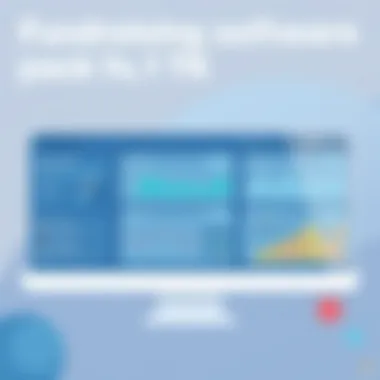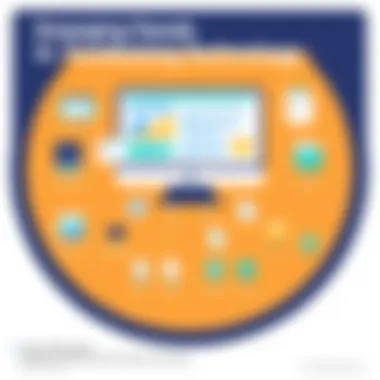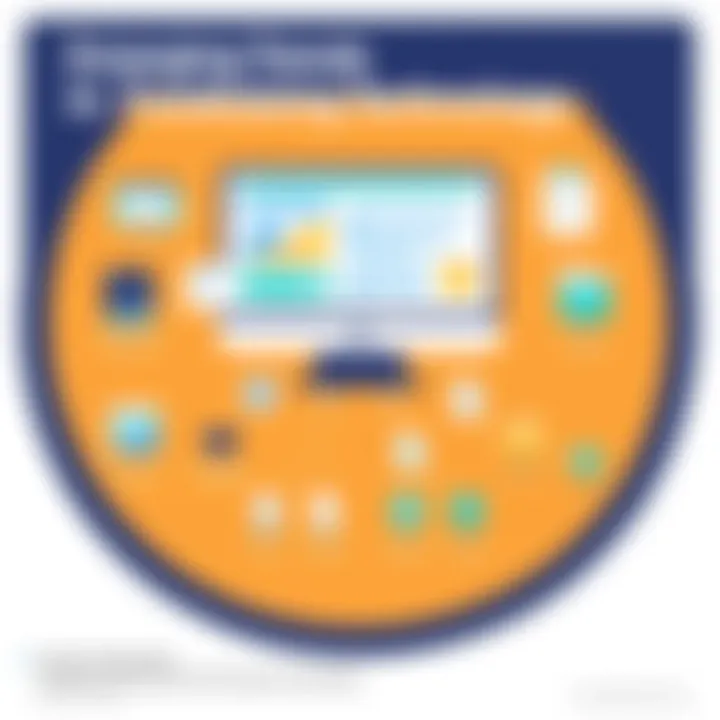Exploring the Landscape of Fundraising Software Companies


Software Category Overview
In today’s technology-driven environment, fundraising software companies hold a crucial role in revamping traditional fundraising methodologies. These software solutions serve as the backbone for organizations looking to optimize their fundraising processes, reaching potential donors through innovative and effective digital platforms. The core purpose of these tools is not just to facilitate the collection of donations but to foster lasting relationships with supporters and donors alike.
Purpose and Importance
The significance of fundraising software goes well beyond mere transaction processing. At its heart, these solutions aim to streamline administrative tasks, allowing organizations to focus more on their mission. By leveraging fundraising software, nonprofits can:
- Automate donation collection and receipts
- Track donor engagement
- Analyze fundraising data for more informed decision-making
Groups can harness these capabilities to enhance outreach, making the fundraising campaigns not only more efficient but also more impactful. In essence, they transform the way organizations interact with their communities.
Current Trends in the Software Category
The digital fundraising landscape is consistently evolving. Recently, there has been a noticeable shift toward integrating features that promote user engagement. We are seeing tools that enable peer-to-peer fundraising and social media integration to elevate the participatory aspect of donation drives.
Some trends worth noting include:
- Mobile Optimization: As mobile devices dominate internet usage, many fundraising tools are enhancing their mobile platforms to ensure usability on smartphones.
- Emerging Technologies: Integration of advanced technologies such as artificial intelligence and machine learning is becoming common, providing insights into donor behavior and improving targeting strategies.
- User-Centric Design: More companies are focusing on user experience, simplifying interfaces to accommodate all demographic groups.
All these trends point to a future where fundraising software becomes increasingly essential as organizations navigate post-pandemic challenges and engage with a more digitally savvy audience.
Data-Driven Analysis
When evaluating fundraising software, metrics play a vital role in determining not only what is available in the market but also what aligns best with an organization's needs.
Metrics and Criteria for Evaluation
Choosing the right software goes beyond surface-level features. Considerations should include:
- Cost: Evaluate the pricing structure and its alignment with your budget.
- Customer Support: Look into the support offered by the software provider; prompt assistance is vital for operational efficiency.
- Integration Capabilities: Ensure the software can mesh well with existing tools your organization uses, such as email marketing platforms or donor databases.
"Choosing the right fundraising software is akin to selecting the right partner in a dance; compatibility and understanding can lead to a graceful performance, while misalignment can result in a step out of rhythm."
Comparative Data on Leading Software Solutions
Let’s take a closer look at some of the prominent players in the fundraising software landscape. Each offers unique features catering to different organizational needs:
- Classy: Renowned for its flexibility and modern design, it shines in peer-to-peer fundraising capabilities.
- Donorbox: This solution is favored for its straightforward setup process and reasonable transaction rates.
- Network for Good: With an all-in-one platform, it helps organizations manage their fundraising and donor relationships effectively.
Choosing a solution that fits your distinct requirements can significantly influence your fundraising success. By conducting a thorough analysis, organizations can make informed decisions that enhance their overall effectiveness in raising funds.
Preface to Fundraising Software
Navigating the modern landscape of fundraising requires not just passion but also the right tools. In this rapidly evolving digital age, fundraising software emerges as a vital asset for organizations striving to gather support and amplify their missions. These platforms streamline the mechanics of fundraising, allowing nonprofits and businesses alike to focus on what matters most—engaging with their supporters and executing impactful initiatives.
Defining Fundraising Software
At its core, fundraising software refers to a suite of digital tools designed to facilitate the management of fundraising activities. This can encompass a wide range of functionalities, from processing donations to managing donor relationships and analyzing campaign performance.
Here are some critical components that make up fundraising software:
- Online donation systems: Enabling seamless contributions from supporters, regardless of their location.
- Event management tools: Helping organizations plan and execute fundraising events efficiently.
- Donor management functionalities: Allowing nonprofits to maintain robust databases of donor profiles, tracking their interactions and contributions.
- Analytics and reporting capabilities: Providing insights into donor behavior and campaign effectiveness.
This software is not merely a convenience; it's increasingly becoming a necessity. In an era marked by technological integration, those who harness these tools can expect a competitive edge in their fundraising efforts.
Importance of Fundraising in Today’s Economy
The role of fundraising in today’s economy cannot be overstated. In a world where charitable organizations and social enterprises rely heavily on donations, understanding the broader economic context enhances the effectiveness of fundraising endeavors.


With an ever-present need for social support systems, fundraising has become critically important due to several key factors:
- Economic Fluctuations: Economic downturns can challenge nonprofit sustainability, highlighting the necessity of diverse funding streams, which fundraising efforts aim to establish.
- Increasing Competition: With countless organizations vying for the same pool of donor dollars, crafting compelling fundraising campaigns through effective software solutions can make a crucial difference.
- Donor Engagement: As public awareness around giving grows, fostering relationships with donors through personalized communication and engaging content is paramount, enabled and simplified by modern software.
"Fundraising is not just about collecting money; it’s about building a community that believes in the cause."
Types of Fundraising Software
In the contemporary landscape of fundraising, understanding the different types of software available is crucial for organizations seeking to leverage technology effectively. Fundraising software solutions serve as essential tools that streamline the donation process, manage donor relations, and enhance event organization. Knowing the strengths and functionalities of each type assists organizations in making informed decisions tailored to their unique needs.
Online Donation Platforms
Online donation platforms have revolutionized how individuals and organizations collect funds. These platforms provide a seamless interface where donors can contribute directly via credit cards, bank transfers, and even cryptocurrencies. Seamless integration with websites and social media channels allows organizations to reach a wider audience.
- Benefits:
- Accessibility: Donors can contribute at any time, from anywhere.
- Tracking: These platforms often offer tracking tools to monitor donations and provide insights into donor behavior.
- Customization: Organizations can tailor their donation pages to reflect their branding and mission, enhancing donor engagement.
A popular choice in this arena is GoFundMe, which offers an intuitive layout and broad reach, appealing to both seasoned fundraisers and newcomers. Through such platforms, organizations can tap into vast networks and foster greater community involvement.
Event Management Software
Event management software is indispensable for organizations planning fundraisers, whether galas, auctions, or community events. This software simplifies the management of every aspect, from registration to ticketing and post-event analysis.
- Key Features:
- Ticketing Solutions: Businesses can automate ticket sales, which reduces manual handling and increases accuracy.
- Communication Tools: Many platforms allow organizers to communicate important updates easily, maintaining audience engagement.
- Feedback Collection: Gathering participant feedback through built-in surveys can inform future events and add value to ongoing engagement.
For example, Eventbrite has carved a niche in this space, offering extensive features designed for optimizing ticket sales and boosting attendee experiences. The ease of use and real-time data management make it a favored choice for many organizations.
Donor Management Systems
At the heart of successful fundraising campaigns lies effective donor management. Donor management systems (DMS) are sophisticated tools that help organizations keep track of their relationships with current and potential donors. These systems provide a structured approach to managing interactions and engagements, ensuring no potential opportunity slips through the cracks.
- Essential Aspects:
- Data Organization: Efficiently organize donor information, from contact details to donation history, in one central database.
- Engagement Tracking: Monitor communication history, preferences, and behaviors to tailor outreach effectively.
- Reporting Tools: Generate insightful reports to analyze fundraising trends, helping organizations shape future strategies.
A solid example in this category is Salesforce Nonprofit Cloud, which integrates donor management with broader CRM functionalities, lightening workloads and improving efficiency significantly.
Crowdfunding Solutions
Crowdfunding solutions democratize the fundraising process, empowering individuals and small organizations to present their causes to the public. These platforms facilitate collective financial backing, encouraging many small contributions toward a shared goal.
- Advantages:
- Broader Reach: Present your cause to a global audience, tapping into a diverse donor base.
- Market Testing: Crowdfunding allows for gauging public interest before committing large resources to a project.
- Community Building: This model encourages a sense of community, with backers often becoming advocates for the cause.
Platforms like Kickstarter and Indiegogo have become household names by fostering innovation and creativity, thus enabling diverse projects to see the light of day. As a result, they continue to play a pivotal role in both nonprofit and for-profit fundraising efforts.
In sum, organizations seeking to enhance their fundraising initiatives must consider the available types of fundraising software as key resources. Each type brings unique benefits to the table, helping to knock down the barriers between organizations and their missions. By aligning the right software solutions with their goals, nonprofits can maximize their impact and foster deeper relationships with their supporters.
Key Features of Fundraising Software
Creating an effective fundraising strategy hinges on the support provided by reliable software solutions. Thus, understanding the essential features of these platforms becomes paramount. Key features not only determine ease of use but also influence the effectiveness of fundraising efforts. These attributes help streamline processes, maximize donor engagement, and ultimately lead to greater financial success. Focusing on the right features enhances the functionality of fundraising software, transforming it into a powerful ally for organizations.
User-Friendly Interface
In an increasingly complex digital ecosystem, a user-friendly interface can't be overstated. It serves as the backbone of the overall experience for both organizations and donors. A clean, intuitive design enables users to navigate the software with ease, minimizing the learning curve. For instance, consider how simple layouts, coherent menus, and clear calls-to-action can reduce confusion for first-time fundraisers. If the interface feels like a maze, chances are that potential donors might abandon their contributions in frustration.
Moreover, mobile responsiveness is increasingly important. As more people engage through smartphones, software that adapts to various screen sizes can better cater to the on-the-go donor. Lists and drag-and-drop features are helpful too, making it easy for users to organize campaigns or even track funding goals.


When it comes to fundraising, remember this: If the software isn't easy to use, no amount of features will make it effective.
Payment Processing Options
A smooth payment processing experience is critical for any fundraising initiative. Your fundraising software should provide a range of payment processing options, accommodating different donor preferences. This means features such as credit card processing, ACH transfers, and even mobile wallets like PayPal or Apple Pay should be in the mix. The more flexible the options, the more likely you are to capture those valuable donations.
Additionally, consider security. Platforms that prioritize encryption and PCI compliance not only protect donor information, but they also build trust. When donors feel safe about their transactions, they are more likely to contribute with confidence. It's also vital that the software provides prompt transaction reports, so organizations can quickly assess their fundraising campaign's financial health.
Reporting and Analytics
Understanding the impact of fundraising activities requires insight into data. Effective reporting and analytics tools embed this necessity within the software. Dashboards that compile various metrics—from donor engagement rates to overall fundraising success—allow organizations to identify what works and what doesn’t.
More specifically, reports should be customizable. For instance, some organizations may wish to track recurring donations while others focus on campaign performance. Being able to measure these different variables gives organizations a sharper lens through which to analyze their efforts. Valuable information helps in refining strategies, optimizing future campaigns, and enhancing donor experiences. As the saying goes,
Considerations for Selecting Fundraising Software
Choosing the right fundraising software is not just a casual decision. It can make or break an organization’s ability to raise funds effectively and efficiently. The importance of selecting appropriate tools can hardly be overstated in today’s fast-paced digital world, where your tech stack can be the difference between reaching goals or falling short. As organizations assess their unique needs, it’s essential to consider various elements that influence the effectiveness of fundraising efforts. This should not be a hasty choice but rather a strategic decision that takes into account several critical facets.
Assessing Organizational Needs
Before diving into various software solutions, it’s crucial to first assess your organization’s needs. What are your goals? Are you primarily focused on online donations, event management, or donor engagement? Each organization has unique missions and priorities, and understanding these will help in narrowing down the options.
Start by defining specific objectives, like increasing donor retention rates or streamlining event planning. Gather insights from team members involved in fundraising activities. Their perspectives can illuminate pain points that software could address. Consider creating a survey or holding a discussion to gather input on desired features.
You might find that a simple online donation platform suffices or that more comprehensive solutions for donor management and event oversight are necessary. Knowing your needs upfront allows you to prioritize which features are non-negotiable versus which are merely nice to have.
Budget Constraints
Money talks, doesn’t it? Budget constraints are often at the forefront when selecting software solutions. Allocating funds wisely is especially paramount in non-profit environments, where every penny counts. Start by setting a clear budget. Think about not just the upfront cost but also ongoing fees, maintenance, and any additional features that could incur extra charges.
There’s a fine line between value and cost. Free solutions might seem appealing, but they often come with limitations that could stifle growth. Conversely, high-end solutions can offer extensive features but may be overkill for smaller organizations. Therefore, drafting a clear budget can help strike a balance.
Consider the following when evaluating costs:
- One-time setup fees
- Monthly or annual subscriptions
- Transaction fees per donation
- Training and support costs
It’s worth considering software that allows scalability—solutions that grow with your organization. After all, you don’t want to implement a system now only to outgrow it in a year’s time.
User Training and Support
Even the most sophisticated software is useless if your team doesn’t know how to use it. When selecting fundraising software, look closely at the user training and support available. It is an often underestimated factor but crucial for ensuring a smooth transition.
Does the provider offer comprehensive training guides? Are there tutorials and live support options available? A software company with robust support can significantly ease the onboarding process.
Users tend to have different learning curves. Some might get the hang of it in no time, while others can struggle. As a result, it's essential to engage with services that offer ongoing support sessions well past the initial setup. Furthermore, encourage your team to share feedback and tips among themselves. A collaborative atmosphere helps everyone feel more competent and comfortable.
"Remember, effective training and responsive support can transform a frustrating experience into a straightforward process."
In essence, selecting the right fundraising software is akin to assembling a reliable toolkit. Assess your needs thoroughly, be realistic about your budget, and ensure ongoing training and support is available. By taking these considerations seriously, organizations can forge a path towards more efficient fundraising efforts, ultimately enabling them to fulfill their missions and make a bigger impact.
Top Fundraising Software Companies
In the digital age, the effectiveness of fundraising efforts heavily relies on the use of specialized software. Top fundraising software companies have become indispensable allies for non-profits, educational institutions, and charitable organizations. These platforms streamline various fundraising processes, automate tasks, and provide valuable insights into donor behaviors. The significance of understanding leading providers lies in recognizing how their features can enhance fundraising campaigns, improve donor engagement, and ultimately drive successful outcomes.
Overview of Leading Providers
When selecting a fundraising software solution, it’s crucial to consider the top players in the market to ensure aligned features with organizational goals. Some notable companies in this space include:
- DonorPerfect: Renowned for its comprehensive donor management capabilities, DonorPerfect enhances user experience with automated reporting tools and donation processing options. Its integration with various payment processors makes it a breeze for organizations to manage funds.
- Classy: This platform excels in online donation and crowdfunding solutions, focusing on user-friendly interfaces that attract a wide range of donors. Classy’s innovative features enable organizations to create beautiful and engaging fundraising pages.
- Blackbaud: A titan in the fundraising sector, Blackbaud offers an all-in-one solution for managing campaigns, donor data, and analytics. Its robust performance in handling large datasets allows for precise targeting of donor segments.
- GiveGab: Particularly popular for event-focused fundraising, GiveGab combines event registration, ticket sales, and idea-sharing in one platform, making it ideal for smaller organizations looking to increase their event impact.
- Kickstarter: While primarily associated with creative projects, Kickstarter has transformed how peer-to-peer fundraising is perceived. It emphasizes community support and offers a unique take on funding, making it a go-to for artistic endeavors.
Each of these companies brings unique qualities to the table. Organizations must assess their requirements to pick one that best suits their particular needs.


Comparative Analysis of Features
Examining the features of different fundraising software companies helps organizations find the best match for their strategies. Here’s a simple breakdown highlighting key elements:
- Usability: Software like Classy prioritizes ease of use, allowing organizations with minimal technical expertise to implement solutions effectively. In contrast, Blackbaud, while feature-rich, may require a steeper learning curve.
- Payment Processing: DonorPerfect offers diverse payment options, accommodating different donor preferences. Evaluate which providers support various payment methods to optimize giving experiences for donors.
- Customization: Kickstarter allows for high levels of customization in campaign pages, encouraging creativity. Software like GiveGab is also customizable, tailoring event pages that align with organizational branding.
- Reporting Tools: Advanced reporting capabilities set Blackbaud apart. It provides organizations with in-depth insights into donor trends, significantly enhancing strategic decision-making.
- Integration with Other Tools: Many fundraising software solutions, especially DonorPerfect, facilitate integration with external apps for email marketing or CRM, promoting streamlined workflows.
"Choosing the right fundraising software is not just about features; it's about aligning the tool with your mission and ensuring it serves your unique needs."
Emerging Trends in Fundraising Software
The digital fundraising landscape is ever-evolving, influenced by rapid technological advancements and shifts in donor behavior. Staying ahead of these emerging trends is crucial for organizations aiming to maximize their fundraising potential. Understanding these trends not only equips organizations with innovative tools but also enhances their ability to engage with donors effectively. Let's explore some of the trends making waves in the sector.
Artificial Intelligence in Fundraising
Artificial Intelligence (AI) is no longer just a futuristic concept; it has seeped into the world of fundraising, transforming how organizations approach donor relations and campaign management. AI can analyze vast amounts of data to predict donor behavior, allowing organizations to tailor their strategies accordingly. For example, AI-driven analytics can identify which donors are most likely to contribute based on their previous involvement and engagement levels. This predictive capability means that organizations can focus their efforts on high-potential donors, ultimately improving fundraising efficiency.
AI chatbots also play a role, providing real-time assistance to potential donors visiting fundraising platforms. They can guide users through the donation process or answer questions about ongoing campaigns, thus enhancing the overall user experience. Moreover, automating certain tasks through AI can free up time for fundraisers to concentrate on more strategic initiatives.
Mobile Fundraising Solutions
In today’s fast-paced, mobile-driven world, having fundraising solutions that are optimized for mobile devices is no longer optional—it's essential. Mobile fundraising allows donors to contribute to their favorite causes from the palm of their hands, making the donation process seamless and immediate.
The rise of mobile wallet systems like Apple Pay and Google Wallet is making financial transactions more accessible than ever. These solutions not only simplify the donation process but also cater to a younger, tech-savvy demographic that prefers using their smartphones over traditional payment methods. Furthermore, mobile fundraising apps can integrate with social media platforms, enabling users to share their fundraising initiatives with friends and family with just a few clicks. This can help multiply the reach of campaigns exponentially.
Peer-to-Peer Fundraising Platforms
Peer-to-peer fundraising is gaining significance as a powerful way to engage supporters and expand donor networks. This approach leverages personal networks to encourage donations. It turns supporters into active fundraisers, enabling them to create personal fundraising pages on behalf of a nonprofit organization.
By tapping into their social circles, individuals can reach potential donors who may not have been aware of the organization beforehand. This trend is not only effective in raising funds but also helps create a sense of community and shared purpose among supporters. Additionally, with the use of social media and digital communication, peer-to-peer fundraising efforts can spread quickly and organically, driving engagement and inspiring others to join in.
"The potential for peer-to-peer fundraising lies in its ability to create a network effect, where each supporter becomes a conduit for broader engagement and donations."
Evaluating Effectiveness of Fundraising Software
When it comes to leveraging technology in fundraising, evaluating effectiveness is not just a good idea; it’s essential. You can have the fanciest system in place, but if it doesn't meet specific goals or make life easier for your organization, what's the point? Understanding how to gauge the effectiveness of fundraising software helps organizations make data-driven decisions that enhance their capabilities. This evaluation not only maximizes the return on investment but also aligns technology choices with overarching fundraising objectives, fostering an environment ripe for success.
Metrics to Monitor
Monitoring the right metrics is arguably the backbone of evaluating any fundraising software. Imagine setting up a new donation platform but failing to track its performance. You’d be flying blind. Here are some key metrics to keep your eye on:
- Total Funds Raised: This is straightforward; knowing how much money your different fundraising efforts generate is crucial. Tracking across platforms gives a clearer picture of success.
- Donor Acquisition Costs: This metric helps you understand how much you're investing to bring in new donors. If this cost is too high, you might need to rethink your strategies or select a different software solution.
- Average Gift Size: Analyze if the average amount donated has increased since utilizing the software. If not, consider whether the platform supports upselling or recurring gifts effectively.
- Donor Retention Rate: A critical metric, this indicates how well you're keeping your existing donors. Software that includes tools to nurture these relationships can significantly enhance retention rates.
- Campaign Performance: Check how various campaigns perform through the software. Some platforms offer detailed insights that make it easier to gauge which types of campaigns resonate with your audience.
"Monitoring the right metrics enables organizations to pivot their strategies efficiently, ensuring their fundraising efforts take flight rather than stall out.”
By closely observing these metrics, organizations can report on success with substantiated data, allowing them to adjust tactics that may not be delivering expected results.
Collecting User Feedback
A key component of evaluating any software is the feedback from the users themselves. Very often these are the people who will interact with the system day in and day out, and their insights can uncover areas that aren’t obvious through analytics alone. Here's how to approach collecting user feedback effectively:
- Surveys and Questionnaires: Compose short, structured surveys to collect specific feedback about features, ease of use, and what might be lacking in functionality. Tailor these questions directly to the software features you want insights on.
- User Interviews: Going a step further, conducting one-on-one interviews or focus groups can yield deep insights. Users may express concerns or suggestions that wouldn’t come out in a survey.
- Support Ticket Analysis: Regularly reviewing the types of issues that users report can help identify recurring problems with the software. If a particular feature triggers numerous tickets, it’s worth investigating further.
- Community Forums: If the software has a user community, extended discussions there can provide raw, unfiltered opinions about what’s working and what isn’t. Observation is key; take note of frequently raised issues or requested features.
Engaging with users not only improves the software's effectiveness but also strengthens the relationship between the organization and its staff. Their perspective on the software’s usability and efficiency may point to improvements that can significantly streamline operations.
The End and Future Directions
The final section of this article highlights the meanings and implications surrounding fundraising software, particularly its future trajectory. As the digital world evolves, so does the need for organizations to adapt and make informed decisions regarding the tools they use for fundraising. The landscape of fundraising technology not only influences how organizations connect with donors but also enriches the overall experience for all parties involved. Understanding these dynamics helps organizations stay ahead in a competitive environment.
Summarizing Key Insights
Throughout this discussion, we have covered various aspects of fundraising software ranging from types and key features to considerations for selection. Here’s a quick recap of key insights:
- Diverse Types of Software: Fundraising tools come in many forms, including online donation platforms, event management software, donor management systems, and crowdfunding solutions. Each type plays a specific role in facilitating effective fundraising efforts.
- Key Features: User-friendly interfaces, numerous payment processing options, robust reporting and analytics, and integration capabilities are crucial elements that enhance the functionality of fundraising software.
- Selection Considerations: When choosing a fundraising software solution, organizations must consider their specific needs, budget, and the level of training and support offered.
As organizations turn to these insights, they can strategize their fundraising efforts in a more focused manner, leading to better donor engagement and higher fundraising efficiency.
Preparing for Future Developments
Looking ahead, the landscape of fundraising software is expected to experience continued innovation and expansion. Here are some notable considerations:
- Embracing Technology Trends: Technologies like artificial intelligence and machine learning are likely to play a larger role in analyzing donor behavior and optimizing campaigns. Organizations will need to stay informed about these shifts and be proactive in implementing solutions that align with these advancements.
- Mobile Optimization: With increasing smartphone usage, optimizing fundraising platforms for mobile devices will likely be critical. Organizations should focus on enhancing mobile interfaces to provide seamless experiences for users.
- Peer-to-Peer Fundraising Growth: This model empowers individuals to raise funds in support of a cause, making it more essential for software solutions to include features that support these grassroots campaigns.
As fundraising software continues to develop, being aware of these trends allows organizations to prepare effectively, ensuring they are not just keeping up, but leading in their fundraising initiatives. In a world characterized by rapid change, flexibility and foresight will be the keys to success.







